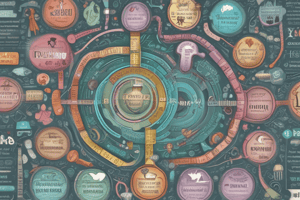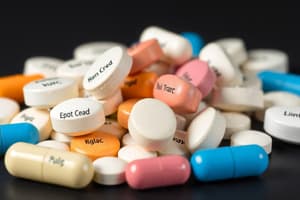Podcast
Questions and Answers
Which type of chemical bond typically results in irreversible drug action?
Which type of chemical bond typically results in irreversible drug action?
- Hydrophobic bonds
- Hydrogen bonds
- Electrostatic bonds
- Covalent bonds (correct)
A drug has a molecular weight of 6. Which characteristic would this drug likely exhibit?
A drug has a molecular weight of 6. Which characteristic would this drug likely exhibit?
- Poor distribution in the body
- Poor absorption in the body
- Lack of sufficient selectivity (correct)
- High selectivity in its actions
What is a key determinant in how the body handles drugs according to the physicochemical classification?
What is a key determinant in how the body handles drugs according to the physicochemical classification?
- The route of administration
- Pharmacological actions of the drug
- Physicochemical properties of the drug (correct)
- The patient's age
Which physicochemical property of a drug influences its distribution and is often measured by the lipid/water partition coefficient?
Which physicochemical property of a drug influences its distribution and is often measured by the lipid/water partition coefficient?
A drug is classified as water-soluble. What would you expect regarding its route of administration for systemic effects?
A drug is classified as water-soluble. What would you expect regarding its route of administration for systemic effects?
For a water-soluble drug, what is the primary route of elimination from the body?
For a water-soluble drug, what is the primary route of elimination from the body?
A patient with renal failure requires a water-soluble drug with a narrow therapeutic index. What adjustment to the dosage is most appropriate?
A patient with renal failure requires a water-soluble drug with a narrow therapeutic index. What adjustment to the dosage is most appropriate?
Which antibiotic agent's disposition is most representative of water-soluble drugs?
Which antibiotic agent's disposition is most representative of water-soluble drugs?
Which of the following is a characteristic feature of drugs with intermediate solubility?
Which of the following is a characteristic feature of drugs with intermediate solubility?
What is a primary characteristic of lipid-soluble drugs that affects their distribution in the body?
What is a primary characteristic of lipid-soluble drugs that affects their distribution in the body?
How are many lipid-soluble drugs metabolized for elimination?
How are many lipid-soluble drugs metabolized for elimination?
Why are unchanged lipid-soluble drugs not effectively excreted in urine?
Why are unchanged lipid-soluble drugs not effectively excreted in urine?
Which physicochemical property is shared amongst acidic drugs that results in similar modes of absorption, distribution, and elimination?
Which physicochemical property is shared amongst acidic drugs that results in similar modes of absorption, distribution, and elimination?
How does a high urine pH affect the re-absorption and clearance of acidic drugs?
How does a high urine pH affect the re-absorption and clearance of acidic drugs?
Which statement accurately describes the plasma presentation of acidic drugs?
Which statement accurately describes the plasma presentation of acidic drugs?
Why might urine pH be controlled when measuring the excretion rates of acidic compounds?
Why might urine pH be controlled when measuring the excretion rates of acidic compounds?
What is the underlying principle behind the use of alkaline diuretics in acute salicylate or phenobarbitone poisoning?
What is the underlying principle behind the use of alkaline diuretics in acute salicylate or phenobarbitone poisoning?
Which characteristic is associated with basic drugs (pKa 6-12)?
Which characteristic is associated with basic drugs (pKa 6-12)?
What happens to the plasma concentration of a basic drug like amphetamine when the urine is made acidic, assuming excretion is a major factor?
What happens to the plasma concentration of a basic drug like amphetamine when the urine is made acidic, assuming excretion is a major factor?
Why is acid diuresis useful in the context of poisoning by amphetamine?
Why is acid diuresis useful in the context of poisoning by amphetamine?
Which type of drug might require a dosage adjustment in patients with impaired hepatic function?
Which type of drug might require a dosage adjustment in patients with impaired hepatic function?
What is a potential consequence of significant binding of a drug to plasma proteins?
What is a potential consequence of significant binding of a drug to plasma proteins?
If a drug has a low molecular weight and is highly lipophilic, what characteristic might be expected?
If a drug has a low molecular weight and is highly lipophilic, what characteristic might be expected?
How does the degree of drug ionization impact its ability to cross cell membranes?
How does the degree of drug ionization impact its ability to cross cell membranes?
Which characteristic is associated with water soluble drugs?
Which characteristic is associated with water soluble drugs?
Which of these drugs can be classified as a water soluble drug?
Which of these drugs can be classified as a water soluble drug?
Which of these drugs can be classified as lipid soluble drug?
Which of these drugs can be classified as lipid soluble drug?
Which of these drugs can be classified as Acidic drugs?
Which of these drugs can be classified as Acidic drugs?
What type of molecules of drugs are alkaloids?
What type of molecules of drugs are alkaloids?
Flashcards
Common drug components
Common drug components
Drugs commonly include inorganic ions, nonpeptide organic molecules, small peptides and proteins, nucleic acids, lipids, and carbohydrates.
What are alkaloids?
What are alkaloids?
Many drugs are alkaloids, which are molecules with a basic pH in solution, often found in nature.
Drug binding types
Drug binding types
Drugs bind to receptors through covalent, electrostatic, or weaker hydrophobic bonds.
Drug handling determinant
Drug handling determinant
Signup and view all the flashcards
Drug major properties
Drug major properties
Signup and view all the flashcards
Water soluble drugs
Water soluble drugs
Signup and view all the flashcards
Intermediate solubility
Intermediate solubility
Signup and view all the flashcards
Lipid-soluble drugs
Lipid-soluble drugs
Signup and view all the flashcards
Acidic drugs (pka 2-7.4)
Acidic drugs (pka 2-7.4)
Signup and view all the flashcards
Basic drugs (pka 6-12)
Basic drugs (pka 6-12)
Signup and view all the flashcards
Study Notes
The Nature of Drugs
- Drugs in common use: inorganic ions, nonpeptide organic molecules, small peptides and proteins, nucleic acids, lipids, and carbohydrates
- Some found in plants or animals, but others are synthetic
- Alkaloids are drugs found in nature, having a basic pH in solution
- Drugs can vary in size from molecular weight (MW) 7 (lithium) to over MW 50,000 (thrombolytic enzymes, antibodies, other proteins)
- Most drugs have MWs between 100 and 1000
- Drugs smaller than MW 100 are rarely selective
- Drugs much larger than MW 1000 are often poorly absorbed
- Drugs bind to receptors with a variety of chemical bonds
- Very strong covalent bonds result in irreversible action
- Somewhat weaker electrostatic bonds exist between a cation and an anion
- Much weaker interactions: hydrogen, van der Waals, and hydrophobic bonds
Physicochemical Classification of Drugs
- Physicochemical properties determine how drugs are handled in the body
- Two major properties: the degree of ionization of the drug molecule in solution and the lipid solubility of unionized drug molecules
- Ionization depends on the pka of the drug and the pH of the fluid
- Lipid solubility is measured at the lipid/water partition coefficient
- There are five groups of drugs classification based on physicochemical properties
- Water-soluble drugs
- Intermediate soluble drugs
- Lipid-soluble drugs
- Acidic drugs (pka 2-7.4)
- Basic drugs (pka 6-12)
Water-Soluble Drugs
- Absorption from the GIT is negligible; injection usually needed
- Distribution is restricted to the ECF
- Binding to plasma protein isn't important, except for strong acids
- The drugs don't penetrate the CSF or brain
- Elimination is mainly by excretion of the unchanged drug in the urine
- Non-renal excretion is unimportant unless MW is greater than 400 Da
- Dosage of water-soluble drugs with a narrow therapeutic index must be reduced in renal failure
- Aminoglycoside antibiotics and gentamicin are representative
Drugs with Intermediate Solubility
- Many are an intermediate between the highly water-soluble aminoglycoside antibiotic agents & the highly lipid-soluble i/v anaesthetic agents
- Tetracycline is included but digoxin is an important example
- Absorption from the GIT is adequate for clinical use but is often incomplete
- Distribution is not restricted to ECF; the drug penetrates cell membranes and into the ICF
- Protein binding influences distribution & elimination
- Elimination is predominantly by excretion of the unchanged drugs in the urine, however, a proportion of the drug undergo metabolism.
Lipid-Soluble Drugs
- This group of drugs is large and includes many drugs that act on the CNS
- They have in common a high lipid/water partition coefficient
- Weakly acidic drugs (pka > 8)-phenytoin and other anticonvulsants
- Virtually neutral drugs – thiopentone and other i/v anaesthetic agents, sedative & inhalation anaesthetics, steroids
- Absorption from the gut is usually rapid and complete unless chemical inactivation occurs
- Initial distribution of the drug is very rapid
- The drug enters tissues, including the brain, at a rate limited by blood flow
- A large proportion of the drug is bound to plasma proteins and to intracellular proteins & lipids
- The concentration of free drug molecules in the body water may be very small indeed
- The concentration of the drug in the glomerular filtrate is very small and the drug molecules are so lipid soluble that they are re-absorbed from the renal tubule
- The unchanged drug is not effectively excreted in urine
- Some of the drugs in this group that have a high vapor pressure are excreted unchanged in the expired air
- Drugs of this group are oxidized in the liver and to a lesser extent in other tissues, to more polar metabolites: alcohols or phenols
- Water-soluble metabolites resemble gentamicin in their elimination
- Many are conjugated with sulphate, glycine or glucuronic acid prior to excretion
Acidic Drugs
- Acidic drugs, with diverse pharmacological actions, have similar modes of absorption, distribution & elimination
- Examples: NSAIDs, aspirin, naproxen, oral anticoagulant agents (warfarin), penicillin antibiotic agent (pen G, ampicillin), sulphonamide antibacterial drugs (sulphamethoxazole), oral hypoglycemic drugs (tolbutamide), diuretic agents (bendrofluazide), barbiturates (phenobarbitone), uricosuric agents (probenecid, sulfinpyrazone)
- All these drugs are donors of H+
- Many acidic drugs are mainly present as the uncharged acid
- The undissociated acid (HA) is more lipid-soluble
- The ionized form doesn't penetrate the cell membrane
- Acidic drugs are largely present in ionized form in plasma
- Plasma clearance varies inversely with the extent of re-absorption from the renal tubule
- High urine pH means no re-absorption & large plasma clearance
- Urine pH should be controlled when measuring excretion rates of acidic compounds
- Alkaline diuretics are useful in poisoning by salicylate or phenobarbitone
Basic Drugs
- Have pka 6-12 with diverse pharmacological actions but similar modes of absorption, distribution, & elimination
- Examples: opioid analgesic agents (morphine), local anaesthetic agents (lignocain), Antidysrhythmic drugs (liginocain), agonist at nicotinic acetylcholine receptor (nicotine), antagonist at muscarinic acetylcholine receptor (atropine), inhibitor of acetylcholinesterase (physostigmine), sympathomimetic amines (noradrenaline), antagonist at adrenoceptor (propranolol), antipsychotic agents (chlorpromazine), tricyclic antidepressant drugs (imipramine), anxiolytic agents (diazepam), antagonist at histamine receptors (chlorphenilamine, cimetidine), antiparasitic drug (chlorquine, piperazine), smooth muscle relaxant agents (theophylline), calcium channel blocker (verapamil, nifedipine)
- All these drugs are acceptors of H+
- Exist almost entirely as non-lipid-soluble cations (BH+) at pH 3; conditions do not favor absorption from the stomach
- In plasma less base is bound to protein than acids and alpha 1-acid glycoprotein is involved rather than albumin.
- Concentration of total drug in urine greatly increases when urine pH is reduced from 8 to 5
- Plasma concentration t1/2 is shortened when excretion is a major factor in elimination (amphetamine) and the urine is made acidic
- Urine pH should be controlled when measuring excretion rate of basic compounds
- Acid diuresis is useful in poisoning by amphetamine
Studying That Suits You
Use AI to generate personalized quizzes and flashcards to suit your learning preferences.




